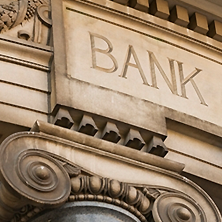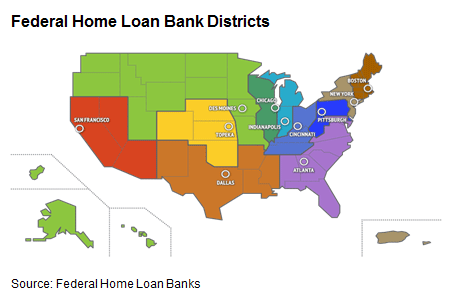
Since their creation in the 1990s, community development financial institutions (CDFIs) have worked to aggregate capital to help economically distressed communities across the United States. Because CDFIs have a mission to serve distressed or low-income communities, they are a natural partner for banks and other investors. Even so, long-term, affordable financing is one of the most pressing and persistent challenges facing the CDFI industry. Regulatory and business cycle pressures have tended to limit the borrowing terms available to CDFIs.
This article will discuss the current state of CDFI-Federal Home Loan Bank (FHLBank) membership. It focuses on several new FHLBank members in the Atlanta region, providing lessons that could be useful to others considering FHLBank membership.
CDFI-FHLBank history
The 2008 Housing and Economic Recovery Act authorized nondepository CDFIs certified by the Treasury Department's CDFI Fund to become members of the FHLBank system. Chartered by Congress in 1932 to support mortgage lending, Federal Home Loan Banks lend to organizations that support housing finance and community development. It was envisioned that CDFI membership in an FHLBank would pave the way for access to low-cost short- and long-term financing and that FHLBank advances, liquidity tools, and grants would provide CDFIs with a new source of capital for lending in low-income communities.
Between 2008 and 2009, the Federal Housing Finance Agency, which oversees the FHLBanks, issued proposed and final regulations. FHLBanks began to reach out to the CDFI industry to help its leaders understand the eligibility requirements and the application process for membership. In 2010, Self-Help Ventures Fund, an affiliate of Self-Help based in Durham, North Carolina, became the first CDFI loan fund member of the FHLBank system.
While many observers expected membership to increase rapidly after the legislation was enacted, that was not the case. Both the CDFI industry and the FHLBanks quickly realized there were a number of questions about each other's mission, business lines, policies, and priorities. It would take meetings, presentations, one-on-one discussions, and additional outreach sessions before CDFI loan funds felt ready to apply for membership.
The number of CDFI FHLBank members has grown incrementally each year since 2010. In 2011, eight CDFI loan funds were approved for FHLBank membership. By year-end 2014, that number had increased to 30. As of December 1, 2015, there were 38 CDFI loan fund members systemwide, including three CDFIs in the FHLBank Atlanta district. There has been progress, yet numerous challenges remain, even as the FHLBanks and the CDFI industry work to increase membership.
CDFI loan funds
CDFIs have been working for decades to strengthen low-income communities by providing affordable capital, credit, and financial services to populations and markets that otherwise lack them. Nondepository CDFIs (loan funds and venture capital funds) and depository CDFIs (banks and credit unions) carry out their mission by focusing their efforts on several areas such as affordable housing; small business financing; health care; education; and training, technical assistance, and counseling services.
CDFI loan funds are nonregulated and typically nonprofit organizations. Because loan funds manage risk in a variety of ways—for example, by providing multiple layers of financing, guarantees, matched funds, peer lending, pooled risk, borrower education, and ongoing technical assistance—they can finance development projects more easily than many other lenders.1 As of December 31, 2015, there were 977 certified CDFIs throughout the United States; of these, 518 were loan funds, and 14 were venture capital funds.2
Federal Home Loan Bank system
The FHLBank system consists of 11 district banks located in the following cities: Atlanta, Boston, Chicago, Cincinnati, Dallas, Des Moines, Indianapolis, New York, Pittsburgh, Topeka, and San Francisco. See the map for each district's boundaries.

FHLBanks are privately owned cooperatives. As such, they can more easily borrow on a large scale in global financial markets. They provide stable, on-demand low-cost funding to their member owners, and these local lenders then lend to their customers. This flow of funds is intended to create jobs, support community and economic development and businesses, and help individuals and families achieve homeownership.
FHLBank members comprise about 7,400 regulated financial institutions (commercial banks and credit unions, including CDFI banks and credit unions, thrifts, and insurance companies) from all 50 U.S. states, possessions, and territories. To become a member, a financial institution must meet certain eligibility requirements and purchase stock; thereafter, it must maintain an investment in the capital stock of the FHLBank to satisfy the minimum required for that institution in accordance with the FHLBank's capital plan.3
New FHLBank members in Atlanta region
CDFI loan funds and FHLBanks have learned a lot about each other as they have worked through issues related to eligibility criteria for FHLBank membership. For CDFI loan funds, it was important for the FHLBanks to understand that, like banks, they make loans using sound underwriting policies and procedures and credit risk analysis. They are also required to maintain conservative self-sufficiency, deployment, and liquidity ratios.
In turn, FHLBanks work to ensure that CDFI loan funds understand their cooperative structure, regulatory requirements, types of programs offered (grants versus debt), and how these programs might or might not meet the loan funds' needs. Even though CDFI loan funds are not required to submit standardized reports, such as the call reports required of regulated financial institutions, their performance measures are reported in their annual audited financial statements. In addition to these statements, some CDFIs use a third-party rating system to verify overall financial strength and stability.
FHLBanks continue to encourage qualified CDFI loan funds to apply for membership. In the Atlanta district, the efforts have resulted in new CDFI members, which worked closely with FHLBank Atlanta staff. Like the other 10 banks in the FHLBank system, FHLBank Atlanta is a cooperative bank that offers competitively priced financing, grants, and other banking services to help its 900-member financial institutions make affordable home mortgages and provide economic development credit to neighborhoods and communities. It is the largest FHLBank in terms of assets as of the third quarter of 2015.
In 2015, three CDFIs became FHLBank Atlanta members: Capital Impact Partners (Virginia) in March, Enterprise Community Loan Fund (Maryland) in April, and Access to Capital for Entrepreneurs (Georgia) in July.
Capital Impact Partners, established in 1981, helps to ensure that low- to moderate-income individuals have access to affordable housing, quality health care and education, and healthy foods. It has disbursed more than $2 billion to revitalize communities over the last 30 years. Headquartered in Arlington, Virginia, Capital Impact Partners operates nationally, with local offices in Detroit, Michigan, and Oakland, California.
For over 20 years, Enterprise Community Loan Fund has invested more than $1.25 billion in communities lacking access to traditional sources of capital. As part of the Enterprise Community Partners family, the loan fund delivers the critical financing needed to ensure access to affordable homes connected to jobs, good schools, transit, and health care. The fund is headquartered in Columbia, Maryland, and it operates nationally.
Access to Capital for Entrepreneurs (ACE), based in Norcross, Georgia, is a 15-year loan fund specializing in small business loans and business advisory services. ACE assists tiny start-ups, large, existing businesses, modest mom-and-pop enterprises, and veteran, seasoned companies by making loans with generous repayment terms and affordable interest rates.
How did a small business lender become a member of an organization with a significant focus on residential finance and affordable housing? Joshua Brackett, ACE's chief financial officer, acknowledged that qualifying for membership with FHLBank Atlanta as a nonhousing small business lender was a challenge. After a number of meetings, though, the two organizations were able to reach an agreement on membership.
The key was that the missions of both ACE and FHLBank—neighborhood development/redevelopment—are aligned. The FHLBank system requires that members demonstrate a commitment to housing; as a subtext, organizations must show a commitment to community and economic development, which is the primary focus of CDFIs such as ACE.
In addition, a criterion for FHLBank membership is the ability to access liquidity. Several years ago, as part of its business model, ACE began accepting real estate as collateral from its small business customers. The property might be the business itself or the residence for a home-based business. ACE had just enough real estate in its portfolio to qualify for FHLBank membership.
Upon membership, FHLBank Atlanta typically assumes a blanket lien on qualifying real estate asset classes held on the institution's balance sheet. This blanket lien can cause disruptions in a CDFI's funding mix. In an effort to work with CDFIs on this condition, FHLBank Atlanta was able to create an addendum to its process; it allowed a lien on specific assets held by ACE, rather than requiring a blanket lien on all of ACE's assets. Through this process, the concern of a blanket asset class lien was addressed, leaving a more flexible funding source.
Progress made, but challenges persist
All three CDFIs in the Atlanta region—Capital Impact, Enterprise Community Loan Fund, and ACE—praise FHLBank Atlanta staff for their guidance through the application process, which can be daunting. While progress has been made to increase the number of CDFI loan funds that are FHLBank members, challenges remain. A major one is the collateralization requirement.
As CDFIs continue to work with FHLBanks and tap into the flexible funding offered, collateral requirements will have to be addressed. The major issue for CDFIs is maintaining enough unencumbered assets to allow coverage on a margined collateral position for the FHLBank advance. CDFIs that have more secured funding sources in their mix will need to show enough excess unencumbered assets to satisfy the overcollateralization requirements for FHLBank advances and to keep their other funders in compliance. It can be difficult, but overall, this is a good option that can be used strategically as a part of the FHLBanks' capital pool.
In spite of these challenges, the CDFI industry and the 11 FHLBanks continue to press forward. CDFIs and FHLBanks have not lost sight of the additional benefits that can result with membership.
FHLBank membership is mutually beneficial for CDFI loan funds and the banks. As FHLBank members, CDFI loan funds have access to advances (loans), liquidity, and grants for housing programs that were previously available only to regulated financial institutions. FHLBanks have an opportunity to work with additional mission-driven lenders that will allow the FHLBanks to broaden their efforts in community and economic development.
The combined forces of these two entities could transform underserved communities in this country for many years to come.
For information on the CDFI loan funds mentioned in this article, visit
- Capital Impact Partners: http://www.capitalimpact.org

- Enterprise Community Loan Fund: http://www.enterprisecommunity.com

- Access to Capital for Entrepreneurs: https://aceloans.org

For additional information about FHLBank Atlanta, see http://corp.fhlbatl.com![]() .
.
By Donna Gambrell, a visiting scholar with the Federal Reserve Bank of Atlanta's community and economic development group
_______________________________________
1 "Strategies for Community Banks to Develop Partnerships with Community Development Financial Institutions," prepared by the Federal Deposit Insurance Corporation, March 2014.
2 CDFI Fund website: https://www.cdfifund.gov![]() .
.
3 U.S. Government Accountability Office, "Federal Home Loan Banks: Collateral Requirements Discourage Some Community Development Financial Institutions from Seeking Membership," April 2015.



